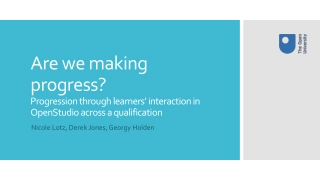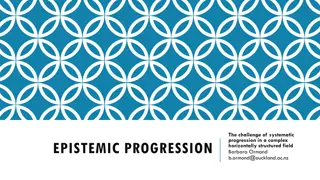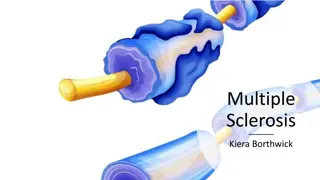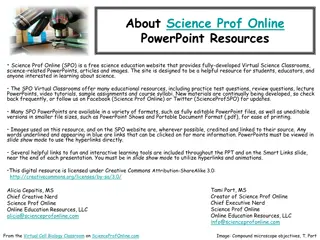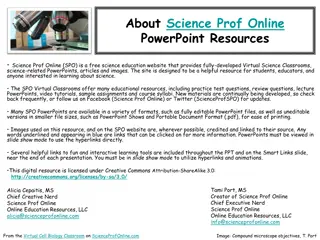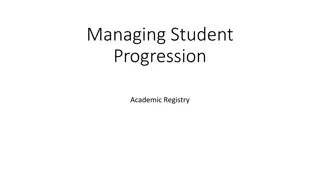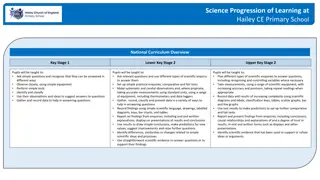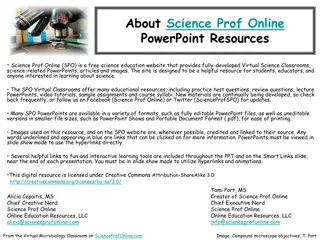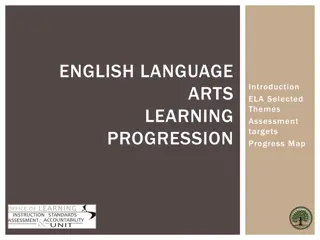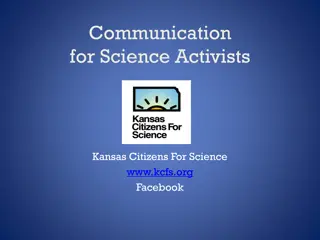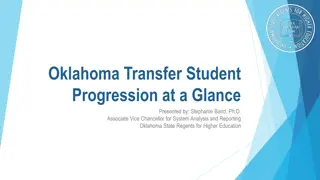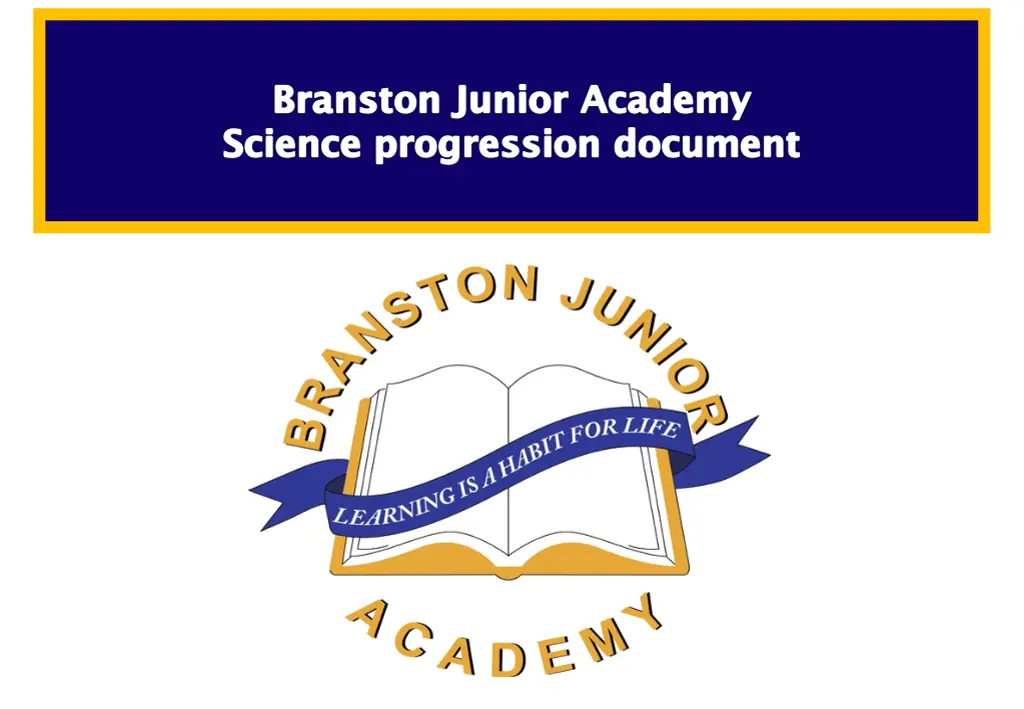
Junior Academy Science Program at Branston: Year-wise Curriculum Overview
Explore the comprehensive science curriculum plan of Branston Junior Academy across different year levels, covering a wide range of topics from animals and habitats to forces and magnets. Dive into the progression of inquiry skills, key vocabulary introductions, and studying scientists, ensuring a rich learning experience for students. Discover the engaging science coverage over a 4-year rolling program, featuring themes like Under the Sea, Chocolate, Extreme Earth, and more. Delve into specific terms like forces and magnets, light, electricity, and human development, designed to enhance scientific knowledge and understanding in young learners.
Download Presentation

Please find below an Image/Link to download the presentation.
The content on the website is provided AS IS for your information and personal use only. It may not be sold, licensed, or shared on other websites without obtaining consent from the author. If you encounter any issues during the download, it is possible that the publisher has removed the file from their server.
You are allowed to download the files provided on this website for personal or commercial use, subject to the condition that they are used lawfully. All files are the property of their respective owners.
The content on the website is provided AS IS for your information and personal use only. It may not be sold, licensed, or shared on other websites without obtaining consent from the author.
E N D
Presentation Transcript
Branston Junior Academy Science progression document
Contents Branston Junior Academy Long Term Plan . p3 Progression of Enquiry Skills NC Working Scientifically p7 Prior and Subsequent learning ......... P11 Key Vocabulary Introduction .....p25 Key Vocabulary Lower KS2 ............................p26 Key Vocabulary Upper KS2 p31 Studying Scientists .p36 2
Science coverage over the 4 year rolling programme at Branston Junior Academy Year A Lower KS2 Upper KS2 Term 1 Under the Sea Animals including humans (digestive system, teeth, food chains) (Y4) Animals including humans (human circulatory system, effects of diet, drugs, exercise and lifestyle, how nutrients and water are transported within animals and humans) (Y6) (HeartStart) Living things in their habitats (Living things can be grouped in a variety of ways / Use classification keys/Changing environments) (Y4) Living things in their habitats (Differences in the life cycles of a mammal, an amphibian, an insect and a bird/Reproduction in some plants an animals) (Y5) Term 2 Chocolate States of matter (Y4) Properties and changing materials (Y5) Term 3 Extreme Earth Forces and magnets (Y3) Forces (Y5) 3
Year B Lower KS2 Upper KS2 Term 1 To infinity and Beyond Rocks and soils (Y3) Light (Y6) Light (Y3) Earth and Space (Y5) Earth and Space (not on LKS2 national curriculum but covered to fit into topic) Term 2 Extinction Plants (Y3) Living things in their habitats (Classifying plants, animals and micro- organisms) (Y6) Animals including humans (food and nutrition / skeletons and muscles) (Y3) Evolution and Inheritance (Y6) Term 3 Inventors Sound (Y4) Electricity (Y4) Electricity (Y6) Animals including humans (human development: birth to old age including puberty) (Y5) 4
Year C Lower KS2 Upper KS2 Term 1 Branston at War Forces and Magnets (Y3) Electricity Forces (Y5) Electricity (Y6) Term 2 British Settlers States of matter (Y4) Properties and changing materials (Y5) Term 3 Rainforests Animals including humans (digestive system, teeth, food chains) (Y4) Animals including humans (human circulatory system, effects of diet, drugs, exercise and lifestyle, how nutrients and water are transported within animals and humans) (Y6) Living things in their habitats (Living things can be grouped in a variety of ways / Use classification keys/Changing environments) (Y4) Living things in their habitats (Differences in the life cycles of a mammal, an amphibian, an insect and a bird/Reproduction in some plants an animals) (Y5) (Heartstart- CPR) 5
Year D Lower KS2 Upper KS2 Term 1 Walk like an Egyptian Light (Y3) Light (Y6) Rocks and Soils (Y3) Term 2 Eco Warriors Plants (Y3) Living things in their habitats (classifying plants, animals and micro-organisms) (Y6) Animals including humans (food and nutrition / skeletons and muscles) (Y3) Evolution and inheritance (Y6) Term 3 Olympics Sound Earth and Space (mini topic- Space Jam) Animals including humans (human development: birth to old age including puberty) (Y5) Earth and Space (mini topic- Space Jam) (Y5) 6
Below are the key areas of the Working Scientifically strands of science, arranged to show the progression from Year 3 to Year 6. Year 3 Year 4 Year 5 Year 6 Planning an investigation From a range of question starts, can generate simple questions that could lead to scientific enquiry. Can suggest a possible series of steps in an investigation. Can suggest which equipment they need to use, and measurements/observat ions that need to be made. With support, can plan a suitable series of steps in an investigation. Selects appropriate equipment and, with support, considers the degree of accuracy required when measuring. Asks questions and can generate simple questions that could lead to scientific enquiry. Ask questions and offers own ideas for scientific enquiry. Using prompts can plan a suitable series of steps in an investigation. May need support in clarifying the question, to suit a scientific purpose. Selects equipment from a range offered (including digital). Considers the degree of accuracy required when measuring. Asks detailed questions and offers an accurately framed question, for a scientific enquiry. Can independently plan a suitable series of steps in a fill investigation. Selects equipment from a range offered (including digital). Takes into account the degree of accuracy required when measuring. 7
Year 3 Year 4 Year 5 Year 6 Fair Testing With support, as part of a fair test, can identify those elements that need to be kept the same. In a fair test, identifies what to change and what to keep the same. Knows when to answer a question through a fair test, or when to use observation or data collection from another source. Sets up a fair test. Considers whether plans will give enough evidence to come to a trustworthy conclusion. Prediction Can make a prediction of a possible outcome and can offer a relevant reason. Can make a prediction of a possible outcome, and can offer a reason based on experience/general knowledge. Can make a prediction of a possible outcome, can offer a reason based on specific scientific understanding of observation. Can make a detailed prediction based on scientific concepts, and is able to represent it as a graph or description of a pattern. 8
Year 3 Year 4 Year 5 Year 6 Safety Follows written safety instructions, linked to equipment. Can suggest simple safety measures. Uses equipment suitably. Can suggest a series of safety measures, following the pattern of the investigation. Can present a series of safety measures, outlining scientific good practice. Collecting evidence Makes relevant observations, creating clear diagrams. Uses standard measuring equipment for quantities such as length or weight. Creates own tables and bar charts. Makes a series of observations. Uses standard measuring equipment for quantities, including temperature and volume. Creates own tables, including a line chart with support. Makes a series of relevant observations. Takes accurate readings on measuring equipment, repeating them when necessary. Creates own tables and graphs, based on average readings. Makes a series of relevant structured observations. Takes accurate readings on a range of measuring equipment, repeating them when necessary. Chooses most suitable method for showing data, including different scales. 9
Year 3 Year 4 Year 5 Year 6 Results and conclusions With support, can describe simple patterns in the results, and begin to explain them. With prompting, recognises limitations of enquiry, and how it might be improved. Makes a general statement about results, supported by patterns. Relates results back to prediction. Suggests how the enquiry might be adjusted or improved. Recognises some of the limitations of the enquiry. With support, identifies linking factors to generate a 'rule'. Supports these with specific evidence, sometimes relating to scientific knowledge. Can discuss how trustworthy their findings are. Established 'rule' and possible exceptions. Relates patterns to scientific knowledge. Can give reasons why other enquires may offer different results. 10
Prior and Subsequent Learning It is important that, as a unit of work is taught, all teachers, and therefore children, are aware of where this particular area of learning fits into the whole curriculum. The following information shows the prior learning for each unit, and states, if necessary, where it then feeds into future units. For some units, such as Animals, Including Humans, due to the structure of our school, children will encounter units in a different order of our two year rolling programme. The year group stated at the top of each column refers to the year group in which the unit fits into the National Curriculum, and is not necessarily the year children will be in as they study this unit. 11
Area of Science: Animals Including Humans KS1 LKS2 UKS2 Y2 notice that animals, including humans, have offspring which grow into adults Year A + C describe the simple functions of the basic parts of the digestive system in humans Year B + D identify that animals, including humans, need the right types and amount of nutrition, and that they cannot make their own food; they get nutrition from what they eat Year A + C identify and name the main parts of the human circulatory system, and describe the functions of the heart, blood vessels and blood Year B + D describe the changes as humans develop to old age. Classifying plants, animals and microorganisms find out about and describe the basic needs of animals, including humans, for survival (water, food and air) identify the different types of teeth in humans and their simple functions recognise the impact of diet, exercise, drugs and lifestyle on the way their bodies function identify that humans and some other animals have skeletons and muscles for support, protection and movement. construct and interpret a variety of food chains, identifying producers, predators and prey. describe the importance for humans of exercise, eating the right amounts of different types of food, and hygiene. describe the ways in which nutrients and water are transported within animals, including humans. Y1 identify and name a variety of common animals including fish, amphibians, reptiles, birds and mammals 12
Area of Science: Animals Including Humans (Cont) KS1 LKS2 UKS2 identify and name a variety of common animals that are carnivores, herbivores and omnivores describe and compare the structure of a variety of common animals (fish, amphibians, reptiles, birds and mammals, including pets) identify, name, draw and label the basic parts of the human body and say which part of the body is associated with each sense. 13
Area of Science: Living things and their Habitats. KS1 LKS2 UKS2 explore and compare the differences between things that are living, dead, and things that have never been alive Year A + C recognise that living things can be grouped in a variety of ways explore and use classification keys to help group, identify and name a variety of living things in their local and wider environment recognise that environments can change and that this can sometimes pose dangers to living things Year B + D Does not feature Year A + C describe the differences in the life cycles of a mammal, an amphibian, an insect and a bird Year B + D describe how living things are classified into broad groups according to common observable characteristics and based on similarities and differences, including micro-organisms, plants and animals give reasons for classifying plants and animals based on specific characteristics identify that most living things live in habitats to which they are suited and describe how different habitats provide for the basic needs of different kinds of animals and plants, and how they depend on each other describe the life process of reproduction in some plants and animals. identify and name a variety of plants and animals in their habitats, including microhabitats describe how animals obtain their food from plants and other animals, using the idea of a simple food chain, and identify and name different sources of food. 14
Area of Science: Evolution and Inheritance KS1 LKS2 UKS2 Y6 recognise that living things have changed over time and that fossils provide information about living things that inhabited the Earth millions of years ago Does not feature - however, it has close links with the life cycles section of Living Things and their Habitats (see previous slide) recognise that living things produce offspring of the same kind, but normally offspring vary and are not identical to their parents identify how animals and plants are adapted to suit their environment in different ways and that adaptation may lead to evolution. 15
Area of Science: Plants KS1 LKS2 UKS2 Y2 explore and compare the differences between things that are living, dead, and things that have never been alive (Living things and their Habitats) Years A + C Does not feature Year B + D identify and describe the functions of different parts of flowering plants: roots, stem/trunk, leaves and flowers Year A + C Does not feature Year B + D describe how living things are classified into broad groups according to common observable characteristics and based on similarities and differences, including microorganisms, plants and animals (Living things and their Habitats) explore the requirements of plants for life and growth (air, light, water, nutrients from soil, and room to grow) and how they vary from plant to plant observe and describe how seeds and bulbs grow into mature plants find out and describe how plants need water, light and a suitable temperature to grow and stay healthy. give reasons for classifying plants and animals based on specific characteristics. (Living things and their Habitats) investigate the way in which water is transported within plants Y1 identify and name a variety of common wild and garden plants, including deciduous and evergreen trees explore the part that flowers play in the life cycle of flowering plants, including pollination, seed formation and seed dispersal. identify and describe the basic structure of a variety of common flowering plants, including trees. 16
Area of Science: Rocks KS1 LKS2 UKS2 Y2 identify and compare the suitability of a variety of everyday materials, including wood, metal, plastic, glass, brick, rock, paper and cardboard for particular uses find out how the shapes of solid objects made from some materials can be changed by squashing, bending, twisting and stretching. (Use of every day materials unit) Year A + C Does not feature Year B + D compare and group together different kinds of rocks on the basis of their appearance and simple physical properties describe in simple terms how fossils are formed when things that have lived are trapped within rock Year A + C Does not feature Year B + D Does not feature recognise that soils are made from rocks and organic matter. 17
Area of Science: Light KS1 LKS2 UKS2 Does not feature Year A + C Does not feature Year B + D recognise that they need light in order to see things and that dark is the absence of light Year A + C Does not feature Year B + D recognise that light appears to travel in straight lines use the idea that light travels in straight lines to explain that objects are seen because they give out or reflect light into the eye notice that light is reflected from surfaces recognise that light from the sun can be dangerous and that there are ways to protect their eyes explain that we see things because light travels from light sources to our eyes or from light sources to objects and then to our eyes recognise that shadows are formed when the light from a light source is blocked by an opaque object use the idea that light travels in straight lines to explain why shadows have the same shape as the objects that cast them. find patterns in the way that the size of shadows change. 18
Area of Science: Forces KS1 LKS2 UKS2 Y2 find out how the shapes of solid objects made from some materials can be changed by squashing, bending, twisting and stretching. (Use of everyday materials unit) Year A + C compare how things move on different surfaces Year B + D Does not feature Year A + C explain that unsupported objects fall towards the Earth because of the force of gravity acting between the Earth and the falling object Year B + D Does not feature notice that some forces need contact between two objects, but magnetic forces can act at a distance identify the effects of air resistance, water resistance and friction, that act between moving surfaces observe how magnets attract or repel each other and attract some materials and not others compare and group together a variety of everyday materials on the basis of whether they are attracted to a magnet, and identify some magnetic materials describe magnets as having two poles recognise that some mechanisms, including levers, pulleys and gears, allow a smaller force to have a greater effect. predict whether two magnets will attract or repel each other, depending on which poles are facing. 19
Area of Science: Electricity KS1 LKS2 UKS2 Does not feature Year A + C Does not feature Year B + D identify common appliances that run on electricity Year A + C Does not feature Year B + D associate the brightness of a lamp or the volume of a buzzer with the number and voltage of cells used in the circuit construct a simple series electrical circuit, identifying and naming its basic parts, including cells, wires, bulbs, switches and buzzers compare and give reasons for variations in how components function, including the brightness of bulbs, the loudness of buzzers and the on/off position of switches identify whether or not a lamp will light in a simple series circuit, based on whether or not the lamp is part of a complete loop with a battery use recognised symbols when representing a simple circuit in a diagram. recognise that a switch opens and closes a circuit and associate this with whether or not a lamp lights in a simple series circuit recognise some common conductors and insulators, and associate metals with being good conductors. 20
Area of Science: Sound KS1 LKS2 UKS2 Does not feature Year A + C Does not feature Year B + D identify how sounds are made, associating some of them with something vibrating Year A + C Does not feature Year B + D Does not feature recognise that vibrations from sounds travel through a medium to the ear find patterns between the pitch of a sound and features of the object that produced it find patterns between the volume of a sound and the strength of the vibrations that produced it recognise that sounds get fainter as the distance from the sound source increases. 21
Area of Science: States of Matter / Properties of changing materials KS1 LKS2 UKS2 Y2 identify and compare the suitability of a variety of everyday materials, including wood, metal, plastic, glass, brick, rock, paper and cardboard for particular uses Year A + C compare and group materials together, according to whether they are solids, liquids or gases Year B + D Does not feature Year A + C compare and group together everyday materials on the basis of their properties, including their hardness, solubility, transparency, conductivity (electrical and thermal), and response to magnets Year B + D Does not feature observe that some materials change state when they are heated or cooled, and measure or research the temperature at which this happens in degrees Celsius ( C) find out how the shapes of solid objects made from some materials can be changed by squashing, bending, twisting and stretching. know that some materials will dissolve in liquid to form a solution, and describe how to recover a substance from a solution identify the part played by evaporation and condensation in the water cycle and associate the rate of evaporation with temperature. Y1 distinguish between an object and the material from which it is made use knowledge of solids, liquids and gases to decide how mixtures might be separated, including through filtering, sieving and evaporating. identify and name a variety of everyday materials, including wood, plastic, glass, metal, water, and rock describe the simple physical properties of a variety of everyday materials 22
Area of Science: States of Matter / Properties of changing materials (cont) KS1 LKS2 UKS2 compare and group together a variety of everyday materials on the basis of their simple physical properties. . give reasons, based on evidence from comparative and fair tests, for the particular uses of everyday materials, including metals, wood and plastic demonstrate that dissolving, mixing and changes of state are reversible changes explain that some changes result in the formation of new materials, and that this kind of change is not usually reversible, including changes associated with burning and the action of acid on bicarbonate of soda. 23
Area of Science: Space KS1 LKS2 UKS2 Does not feature Y3 Does not feature Y4 Does not feature Y5 describe the movement of the Earth, and other planets, relative to the Sun in the solar system Y6 Does not feature describe the movement of the Moon relative to the Earth describe the Sun, Earth and Moon as approximately spherical bodies use the idea of the Earth s rotation to explain day and night and the apparent movement of the sun across the sky. 24
Scientific Vocabulary Key Vocabulary: The National Curriculum that s that: Lower KS2 Pupils should read and spell scientific vocabulary correctly and with confidence, using their growing word reading and spelling knowledge. Upper KS2 Pupils should read, spell and pronounce scientific vocabulary correctly. At Branston Junior Academy: In addition to scientific vocabulary being displayed on working walls in the classroom, children will be given a vocabulary list to stick in books at the start of a new unit of work. This will be frequently referred to during science lessons and when other appropriate situations arise, for example if topic work is linked to science learning. As the unit of work progresses, children will ensure they can explain the meaning of the topic words and that they are using them effectively within written work. The accurate spelling of these words will be encouraged and spelling will be reinforced; children will be prompted to look back at this list in order to check the accurate spelling. Lists of agreed key vocabulary for each unit of work follow. 25
Key Vocabulary LKS2 26
Animals Including Humans (Digestive system, Teeth and Eating, Food Chains) mouth tongue teeth oesophagus stomach small intestine large intestine consumer herbivore omnivore carnivore tooth Helping Plants Grow Well plants light warmth water leaves roots stem flower grow growth height life cycle States of Matter solid liquid gas evaporation condensation melt freeze solidify particles temperature heating cooling teeth canine incisor molar producer predator prey food chain 27
Living things and their Habitats habitat nutrition environment keys condition consumer producer organism predator prey food chain similar Sound vibrate vibrating vibration air ear sound volume pitch faint high low loud Electricity electricity electrical circuit battery bulb crocodile clip buzzer motor conduct conductor insulate 28
Rocks rock slate granite chalk sandstone soil fossil Forces and Magnets magnet spring metal iron copper aluminium steel brass attract repel Light light dark shadow transparent translucent opaque direction shortest longest highest object clay sand limestone quartz marble stone magnetic non-magnetic attraction repulsion elastic pull towards push away from stretch squash compress 29
Animals Including Humans; Diet, nutrition, skeletons and muscles skeleton bone bones ribs spine skull vertebrate contract relax contraction joint move muscle muscles nutrition vitamins minerals fat protein carbohydrates water diet 30
Key Vocabulary UKS2 31
Animals, including humans Keeping Healthy - circulatory system, diet, exercise, balanced lifestyle Light Living things and their habitats Life Cycles light beam reflect reflection opaque mirror light travelling source reflected travel block shiny surface reproduce reproduction fertilisation Pollinate diet balanced diet side effects fats sugars starches food types heart circulation heart beat pulse pulse rate muscle blood blood vessel lung breathe growth activity exercise drugs lifestyle alcohol stamen stigma sepal petal ovary pollen style germinate germination fertilise Pollination disperse dispersal mammal amphibian insect bird sexual asexual 32
Forces Evolution and Inheritance gravity air resistance water resistance friction surface force effect accelerate decelerate brake change direction stop living things change fossils offspring vary not identical characteristics variation evolution adaptation inherit inheritance adapt environment extreme conditions mechanism pulley gear spring theory of gravitation 33
Electricity Earth and Space Properties and changing materials circuit complete circuit conductor insulator symbol circuit diagram electricity component voltage cell battery Earth Sun Moon sphere revolve orbit spin rotate axis sunrise sunset light source shadow solar system geocentric heliocentric materials properties soluble transparent opaque conduct dissolve solution solids liquids gases mixture separate filter sieve evaporate reversable irreversible condense 34
Animals Including Humans Human Development Classifying plants, animals and micro-organisms classify classification group vertebrates invertebrates fish amphibians reptiles birds mammals micro-organisms microbe germ virus bacteria grow change puberty reproduction reproduce life cycle baby child adolescent adult 35
Studying Scientists Autumn Spring Summer A Year 3/4- Chris Packham Year 5/6- Marie M Daly, David Attenborough, Joseph Banks Year 3/4- Bernard Palissy Year 5/6- Becky Schroeder Year 3/4- Michael Faraday Year 5/6- Galileo Galilei, Isaac Newton B Year 3/4- Justus Von Liebig, Mary Anning Year 5/6- Abu Ali al-Hasan, Ben Jensen, Nicholas Copernicus, Maggie Aderin-Pocock Year 3/4- Wilhelm Conrad Rontgen, George Washington-Carver, Monique Simmonds Year 5/6- Rachael Carson, Carl Linnaeus Year 3/4- Thomas Edison, Christian Doppler Year 5/6- Nicholas Tesla, Peter Rawlinson, Charles Darwin, Rosalind Franklin, Sarah Fowler C Year 3/4- Michael Faraday Year 5/6- Galileo Galilei, Isaac Newton, Year 3/4- Bernard Palissy Year 5/6- Becky Schroeder Year 3/4-Chris Packham, Jane Goodall, Seirian Sumner Year 5/6- Marie M Daly, David Attenborough, Joseph Banks D Year 3/4- Thomas Edison, Mary Anning Year 5/6- Abu Ali al-Hasan, Ben Jensen, Nicholas Tesla, Peter Rawlinson, Year 3/4- Wilhelm Conrad Rontgen Year 5/6- Rachael Carson, Carl Linnaeus Year 3/4- Thomas Edison, Christian Doppler Year 5/6- Charles Darwin, Rosalind Franklin, Sarah Fowler, Nicholas Copernicus, Maggie Aderin-Pocock 36


